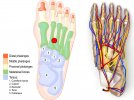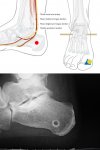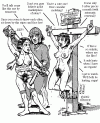If it were me being crucified, what could I expect? Would I still be able to slowly move my fingers and toes or would the trauma from the nails in my wrists and feet cause enough damage that movement of those smaller digits would be cut off eventually and even go numb well into the execution? It passes through bone, muscles, and severs nerves so I wondered about that.
My fantasy is that while they would be damaged and become slower, I could still move them or have others around me manipulate them as they see fit, but the reality may be different.
Well ... when we get crucified it always depends a lot on what our crucifiers actually
want, and what tools and methods they choose for the job!
So it matters
where they put the nail, what
kind of nail they choose, and
how they drive it through...
let's look at the foot.
I've shown one place where many crucifiers like to place a nail.
They can pound it through without having to crush bones or push them grotesquely away from their normal position. But if you look at the schematic with nerves and blood vessels in it, it's not 'just flesh' there.
Blood vessels don't work like plastic pipes though ...they can roll around quite a bit, shift aside.
So if the crucifier wants us to keep as much function as possible ...

... they might pick a round cross-section nail, that is not needle-sharp (so that it doesn't puncture), and they would tap it through slowly, so that the relatively blunt tip presses tissue aside, more than it cuts through. If he wanted to, an experienced cruxer could probably avoid severing much in the way of nerves and vessels.
If instead he picked a nail with square cross-section, perhaps with ragged edges, a sharp tip, and pounded it through with one enormous blow ... there would likely be much much more immediate tissue damage.
One would not rapidly bleed out from this nor would sensitivity or motion be lost in all the toes.
He could also place the nail higher up, perhaps between cuboid and the cuneiform beside it (between 2 & 1)
That's what might happen during the nailing...
as the crucifixion continues of course there's more.
Having to rest significant parts of our bodyweight on a thin piece of metal will cause additional damage.
This will compress and crush tissue and begin to press bones apart.
There's a membrane on the outside of the bone called the periosteum which is extremely sensitive to pain - while the bone on the inside has no pain reception at all.
So things grinding against the outer surface of the bone such as a jagged nail is going to be ridiculously painful.
Then there will be swelling which while it can reduce bleeding will cause any movement to be more painful.
All in all it'll just be very very painful to move so much as a toe.
And then of course, there can be issues with cramping, and unrelieved pressure.
(Forced standing in one position is considered a torture in and of itself if done for considerable periods of time!)
As hours drag into days inflammation/infection become a concern.
There's a second popular way of nailing the foot, through the heelbone

here it is pretty easy to avoid major nerves and blood vessels.
In fact this diagram is for a medical procedure that places the nail at the red dot (in the medical context they call it a 'pin')
As it is, once it's in, it's actually practically painless (I can attest) -- the weight put on it for medical purpose is only a few kg though and everything is done with care.
Of course having to put half your bodyweight on a nail through the heelbone is also quite something else!
But there isn't any direct damage at all, to sensitivity or motion of the toes.
So all in all, if the crucifier
wants us to be able to feel things in our toes, and maybe wriggle and curl them a bit ... he can do that!
But as Tree points out ... even if the nail is very carefully driven through, to avoid nerve and blood vessel damage ...
... still we are crucified, helplessly and hopelessly fixed to the hurt-beam.









